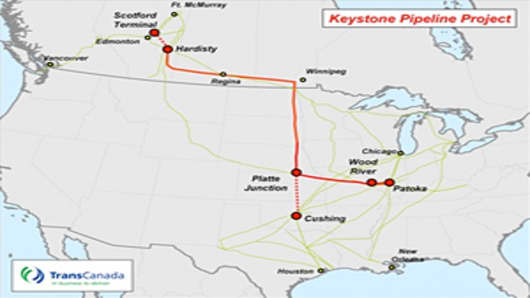President Obama has hailed infrastructure programs as the key to his plan to get Americans back to work.
While the president’s jobs bill faces an uphill battle in Congress, there is a massive energy infrastructure project the administration could green light on its own: TransCanada’s $7 Billion Keystone XL project.
The proposed 2,000-mile pipeline project would transport more than half a million barrels of oil a day from the tar sands in Alberta, Canada, across the border and through six states in the U.S., to the major U.S. refiners on the Gulf Coast of Texas.
Because the Keystone XL would originate in Canada, its approval comes under the State Department’s jurisdiction. After concluding the final environmental impact statement, which found no inherent risk to the project, the agency is now holding public hearings in the states along the pipeline’s route: Kansas, Montana, Nebraska, Oklahoma, South Dakota and Texas.
The oil pipeline marks an ambitious expansion project for TransCanada, which in 2010 derived roughly half of its revenues from natural gas pipelines.
In the U.S., the proposal has seen some unlikely alliances on both sides of the debate regarding potential impact on jobs and the environment.
Supporters: Energy and Labor
The Canadian infrastructure firm TransCanada estimates the construction of the pipeline and manufacturing of materials to build it will create 20,000 full-time jobs in the U.S. over the two years it will take to complete the project. And the company is conducting a full court press to lobby for support.
“We’re building what is the largest infrastructure project in North America,” said TransCanada spokesman James Miller, expressing confidence the pipeline will be approved. “We’re putting a lot of people to work.”
The projected job numbers have won TransCanada support from labor unions like the Teamsters, and business trade groups including the National Association of Manufacturers and the American Petroleum Institute.
“When you’re talking $7 billion, a lot of people will benefit.” Miller said.
A study the company commissioned by the Perryman Group claims the permanent increase in oil supplied through the Keystone XL pipeline will add more than 250,000 permanent U.S. jobs and add more than $100 billion in annual spending to the U.S. Economy.
“It’s the largest shovel-ready project out there,” says Marty Durbin, Executive VP for API, who notes that importing more oil from Canada rather than more volatile suppliers in the Middle East or Africa provides an added national security benefit for the United States.
“Getting that resource from Canada is a win-win all around,” he said.
Opponents: Environmentalists and Nebraskans
Environmentalists argue the Keystone XL pipeline is ultimately a losing proposition for the United States because of the risk of leaks along the route, which crosses thousands of acres of farmland in the Midwest and sensitive waterways like the Yellowstone River in Montana.
“TransCanada’s own country has rejected these types of projects because of the environmental risks they involve. They do not have a coastal pipeline in Canada, Canadians have said no to it,” said Lena Moffitt, Federal Policy Representative with the Sierra Club.
Beyond leaks, activists at the Natural Resources Defense Council and the Sierra Club contend tar sands oil is a dirty fuel, producing higher levels of greenhouse gas emissions and pollution in the refining process.
“Asking Americans to shoulder that kind of environmental burden and threaten their air and drinking water simply doesn't make sense,” argued Moffitt.
The environmentalists have found an ally in conservative Nebraska over the issue of potential water contamination. Republican Gov. Dave Heineman is among those in the state opposed to the project over the pipeline’s proposed route across the Ogallala Aquifer.
If the pipeline is approved, Nebraska officials have said they will lobby to have the final route changed away from the watershed.
TransCanada officials said they have already agreed to implement dozens of improvements along the pipeline, which helped lead the final environmental impact study to conclude the project was safe. Still, a spokesman admitted winning support in Nebraska remains a challenge.
Pipeline Capacity Need
For the oil industry, the Keystone XL pipeline represents much-needed infrastructure in a part of the country where oil production is booming. North Dakota's Bakken Shale oil volumes have exploded from less than 3,000 barrels a day in 2005 to over 230,000 barrels in 2010, according to the U.S. Energy Information Agency. But the pipeline infrastructure in the Midwest runs from South to North.
“We used to import into the Gulf Coast and we'd ship it up pipelines into the mid-continent as far North as Chicago,” oil industry consultant Andy Lipow of Lipow Associates, explained. “Now, what we want to do is take oil from the north, namely Canada and North Dakota, and ship it south to the Gulf of Mexico.”
With no pipelines running to the major refiners on the Gulf coast, home to more than half of the nation’s refining capacity, much of the new oil is effectively landlocked.
“There’s a rising inventory of oil that is trapped in the Midwest,” said senior EIA economist Antoine Halff. “Because it's stranded, its price is moving to a deeper discount to other grades such as gulf coast grades.”
Even as oil prices have come down, the logistical logjam has kept crude prices on the Gulf Coast cash market at a $20 premium above the price of Nymex crude, spawning a virtual pipeline of oil shipments to move Midwest crude to the more lucrative Gulf market.
More than 33 million barrels of crude oil were shipped by rail in 2010, according to AAR Freight Commodity research, a 200 percent increase from 2005. Meantime, energy department data show more than 5 million barrels of crude were shipped by barge and tanker shipments from the Midwest to the Gulf in June of this year, a 420 percent increase over shipments in 2005. But those numbers pale in comparison to the potential capacity of transporting more than 500,000 barrels a day through the Keystone XL extension from Cushing to Texas refiners.
Decision Expected By Year’s End
The State Department is expected to issue a so-called National Interest Determination, or NID by December, and circulate it to other agencies involved, including the Environmental Protection Agency. If agencies don’t agree unanimously on approval, the decision is then up to President Obama.
Canadian Prime Minister Stephen Harper predicted in a recent interview that the approval of the Keystone XL pipeline should be a “complete no-brainer” for the Obama administration when it comes to creating jobs. TransCanada officials are not entertaining the possibility of anything but approval. When asked what steps the company will take if the project is denied, spokesman James Miller replied, “There’s no contingency. There is no plan B.”





